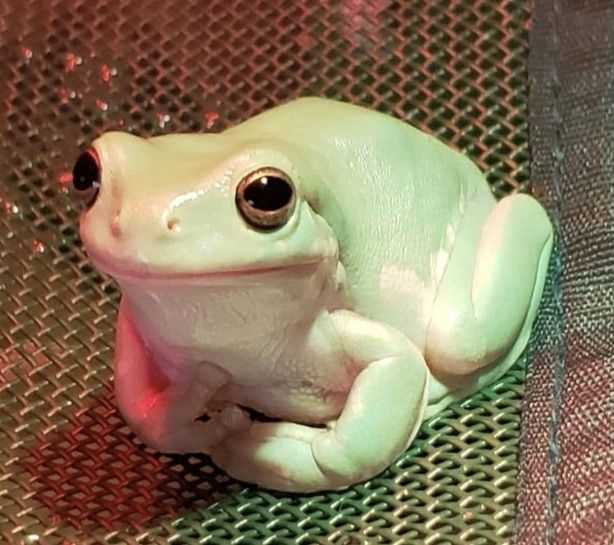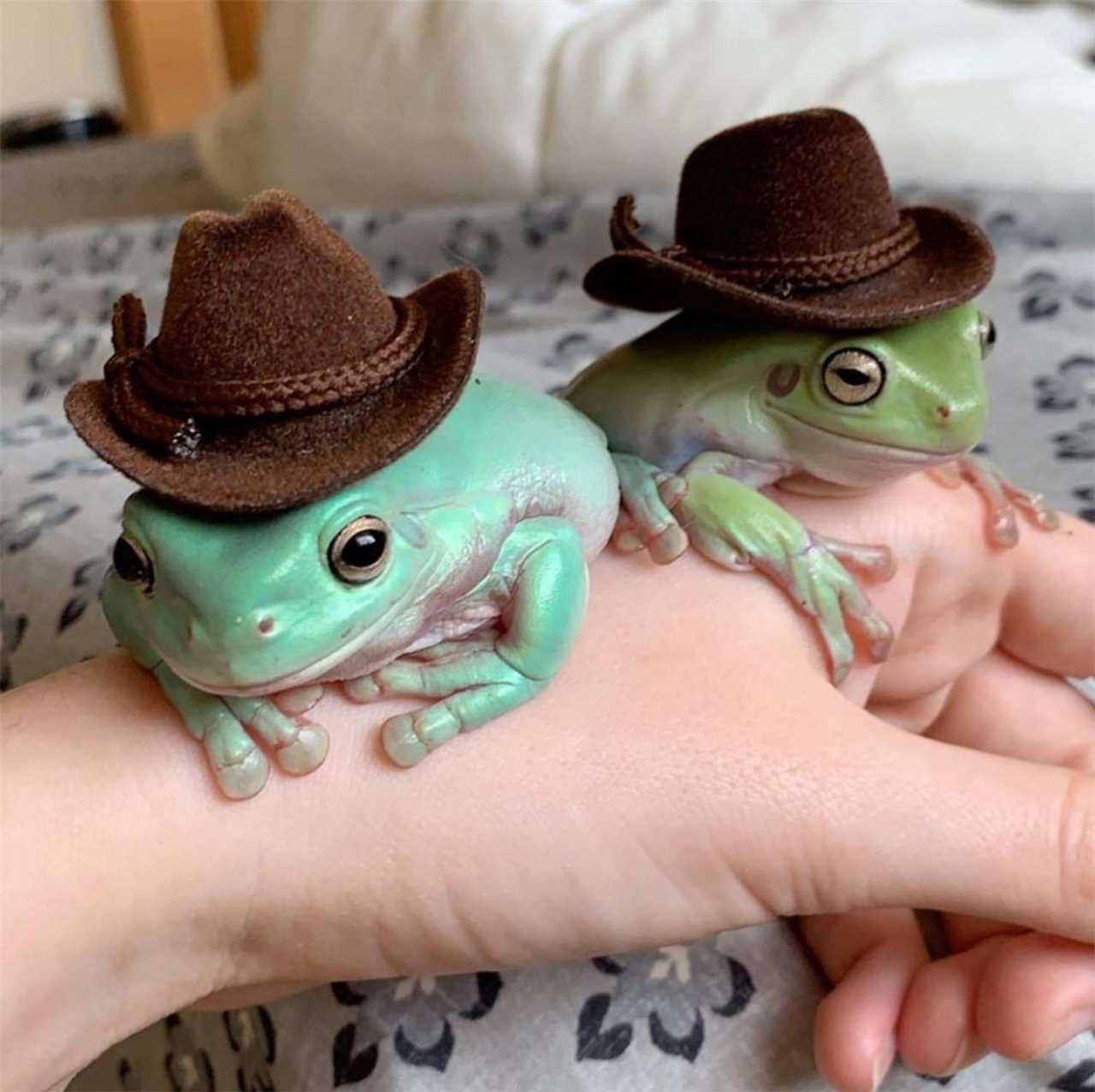The Whites Tree Frog has a unique ability to change its color depending on its mood and surroundings. It can range from bright green to dark green, or even light blue. This ability not only makes it visually appealing but also helps it blend in with its environment.
If you’re considering getting a pet frog, the Whites Tree Frog is a great choice. It’s relatively easy to care for and can live up to 16 years if properly taken care of. With its adorable appearance and friendly demeanor, this frog is sure to bring joy and happiness to any frog lover’s life.
Adorable Whites Tree Frog
Physical Characteristics
The Whites Tree Frog is a medium-sized frog, with adults typically reaching a length of 4-5 inches. It has a stocky build, short limbs, and smooth, moist skin. The coloration of the skin can vary, but it is usually a vibrant green, which provides excellent camouflage in the trees where it spends the majority of its time. The frog’s eyes are large and round, often described as looking “googly,” adding to its adorable appearance.
Habitat
The natural habitat of the Whites Tree Frog includes the rainforests and wetlands of Australia, Papua New Guinea, and Indonesia. They are arboreal creatures, meaning they spend most of their time in trees and vegetation. These frogs are well-adapted to their arboreal lifestyle, with large toe pads that help them grip onto surfaces and move with ease.
In captivity, the Whites Tree Frog requires a spacious enclosure that mimics its natural habitat. This includes providing ample climbing opportunities, such as branches and plants, as well as a shallow water dish for soaking. They are relatively low-maintenance pets and can thrive in a variety of temperature and humidity conditions.
Feeding and Diet
The Whites Tree Frog is an opportunistic feeder, meaning it will eat just about anything it can fit into its mouth. In the wild, their diet consists mainly of insects, such as crickets, beetles, and moths. In captivity, they can be fed a diet of gut-loaded crickets, mealworms, and even small mice on occasion.
Behavior
During the day, the Whites Tree Frog is typically inactive, hiding in the foliage and sleeping. They become more active and vocal during the evening and night, with males often producing loud and melodic calls to attract a mate.
Reproduction
Conservation Status
The Whites Tree Frog is classified as a species of least concern by the International Union for Conservation of Nature (IUCN). This status means that the population of Whites Tree Frogs is stable and not currently at risk of extinction.
However, habitat loss due to deforestation and pollution can have a significant impact on their numbers in the wild. It is crucial to support conservation efforts and promote responsible pet keeping to ensure the well-being of these adorable frogs.
Physical Characteristics
The Whites Tree Frog has large, bulging eyes that provide excellent vision. These eyes have a golden color and vertically elliptical pupils, allowing the frog to see in a wide range of light conditions. By positioning its eyes on top of its head, the frog can survey its surroundings and detect potential predators or prey.
Skin

The skin of the Whites Tree Frog has a unique texture. It is covered in tiny bumps or tubercles that help to camouflage the frog, making it harder for predators to spot. Additionally, these bumps can secrete toxins that provide a form of defense against predators.
Limbs and Feet
One characteristic that sets the Whites Tree Frog apart is its large, adhesive toe pads. These specialized pads allow the frog to easily grip onto various surfaces, such as tree branches and rocks. This adaptation enables the frog to climb and jump with agility, making it a proficient tree dweller.
The limbs of the Whites Tree Frog are relatively short and stout, ideal for navigating within its arboreal habitat. Its hind legs possess powerful muscles, allowing for impressive leaps and jumps. When it jumps, the frog extends its hind legs, propelling itself forward and creating an impressive display of acrobatics.
Habitat
These frogs are excellent climbers and can be found living in trees, bushes, and other vegetation. They have large, sticky toe pads that allow them to cling onto surfaces and move effortlessly in their arboreal habitat.
Preference for Wet Environments
Urban Adaptation
They are attracted to areas with artificial lighting, which can provide them with additional prey opportunities. Their adaptability to urban habitats makes them a common sight in parks, backyards, and even inside houses, where they seek shelter from extreme weather conditions.
| Common Name | Scientific Name | Habitat |
|---|---|---|
| Whites Tree Frog | Litoria caerulea | Tropical and subtropical forests, gardens, urban areas |
Feeding and Diet
In the wild, their diet consists mainly of insects such as crickets, beetles, moths, and spiders. They are also known to eat small reptiles, birds, and other frogs. They are equipped with a sticky, extendable tongue that they use to catch their prey in the blink of an eye.
| Food | Amount | Frequency |
|---|---|---|
| Insects (crickets, beetles, moths, spiders) | Every other day | |
| Small reptiles, birds, and other frogs | Occasionally (as live food) | As needed |
| Crickets, mealworms, waxworms | 5-10 per feeding | 2-3 times a week |
| Small mice (optional) | As needed | Once a month or less |
It is also essential to provide clean, chlorine-free water for your Whites Tree Frog. They should have access to fresh water at all times, either in the form of a shallow dish or a misting system.
Remember, maintaining a healthy diet is crucial for the overall well-being and longevity of your frog, so always ensure that they are receiving a nutritionally balanced diet.
Adorable Tree Frog Behavior
The adorable tree frog is known for its captivating and unique behavior. These fascinating creatures display a range of interesting actions and characteristics that make them a delight to observe and study.
One of the most unique behaviors of the adorable tree frog is its ability to camouflage itself. These frogs have the incredible ability to change their skin color to match their surroundings, making them nearly invisible to predators. This adaptation allows them to hide from potential threats and ensures their survival in the wild.
In addition to their impressive camouflage skills, adorable tree frogs are also known for their agile climbing abilities. These amphibians have specialized toe pads that assist them in gripping onto various surfaces, allowing them to effortlessly navigate through trees and plants. Watching them effortlessly move through their natural habitat is a truly remarkable sight.
Another interesting behavior of the adorable tree frog is its vocalizations. Male frogs produce unique and melodious calls to communicate with other frogs. These calls are often used to attract females or to establish territory. The sounds produced by these frogs can be quite soothing and are often associated with the tranquility of natural habitats.
Furthermore, these frogs are also skilled hunters. They display exceptional accuracy and speed when catching their prey, which mainly consists of insects and small invertebrates. Their long, sticky tongue allows them to capture their prey with precision, making them effective predators despite their small size.
Overall, the adorable tree frog showcases a range of captivating behaviors that contribute to their charm. Their ability to change colors, climb with ease, vocalize melodiously, and hunt with precision make them a truly exceptional creature. Observing and studying the behavior of these frogs provides invaluable insights into the fascinating world of amphibians and their unique adaptations.
Reproduction of the Adorable Whites Tree Frog
During the breeding season, which typically occurs during the wet season, males will make distinctive and loud mating calls to attract female frogs. These calls can be heard for long distances and serve as a way for the males to establish territories and attract potential mates.
After fertilization, the female will lay her eggs in a suitable location, usually in water or on leaves near a water source. The eggs are typically laid in large clumps and can number in the hundreds or even thousands. The female will then leave the eggs to develop on their own.
Once the tadpoles have completed their metamorphosis and have fully developed into frogs, they will leave the water and venture out onto land. At this point, they are considered to be independent and will begin their life as adult tree frogs. They are now capable of reproducing and continuing the cycle.
The reproduction process of the adorable Whites Tree Frog is not only interesting but also vital for the survival of the species. It is through this process that new generations of these charming frogs are born and get the chance to enchant us with their adorable appearance and joyful presence.
The Conservation Status of the Adorable Whites Tree Frog

Habitat Loss: One of the main threats to the Whites Tree Frog is habitat loss. With the increasing human activities like urbanization, agriculture, and deforestation, the natural habitats of these frogs are being destroyed. The clearing of forests and wetlands reduces the availability of suitable places for the frogs to live and reproduce.
Climate Change: Another significant factor that impacts the conservation status of the Whites Tree Frog is climate change. As temperatures increase and rainfall patterns become more erratic, these changes can affect the availability of water sources and disrupt the breeding cycles of the frogs.
Invasive Species: The introduction of invasive species like the Cane Toad has also posed a threat to the survival of the Whites Tree Frog. These aggressive predators eat the young frogs and compete with them for food, reducing their chances of survival.
Pollution: Pollution, particularly water pollution from pesticides and fertilizers used in agricultural practices, can contaminate the habitats of the Whites Tree Frog. This pollution can affect the water quality and food sources, negatively impacting their health and reproductive abilities.
The conservation of the Adorable Whites Tree Frog is crucial to maintain the biodiversity and ecological balance of their native habitats. Efforts are being made to protect and restore their natural environments, implement stricter regulations on land use, and raise awareness about the importance of preserving these species.

I’m Lena Adams—a product of an unconventional upbringing in the African wilderness. My father, a daring explorer of African wildlife, sparked my fascination with reptiles, a passion that intertwined with the tragic loss of my mother during an expedition, leaving an indelible mark on my life. Driven to understand the creatures that captivated my parents, I embarked on my journey, sharing insights about reptiles, frogs, and lizards on my website. Through my explorations and conservation efforts, I honour my family’s legacy while seeking connections—to the creatures, nature, and the mother whose presence I yearn to understand.
